Developpement - Development
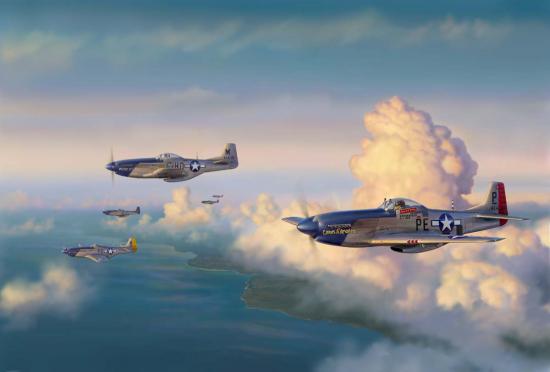
"Almost home" © Jim Laurier - www.jimlaurier.com
Le P-51B-NA exista en 4 lots : les lots -1, -5 (dont 550 furent rebaptisés -7 avec un réservoir d'essence derrière le pilote) et -10 étaient équipés du moteur Packard (Merlin) V-1650-3 de 1400 CV (au décollage) et le -15 du V-1650-7 de 1450 CV (une autre source indique que le V-1650-7 fut monté sur les B-10). Le P-51 devait pouvoir assurer des misisons d'escorte jusqu'en Allemagne ; le bidon auxiliaire de 284 litres existant à l'époque était insuffisant.
The P-51B-NA existed in 4 lots : the lots -1,-5 (with 550 units renamed -7 with extra fuel tanks behind the pilot's seat) and -10 were fitted with the engine Packard (Merlin) V-1650-3 of 1400 HP (when taking off) and the -15 with the V-1650-7 of 1450 CV (another source indicates that the V-1650-7 was fitted on the B-10). The P-51 had to be able to ensure escort missions over Germany ; the existing auxiliary tank of 284 liters was insufficient.
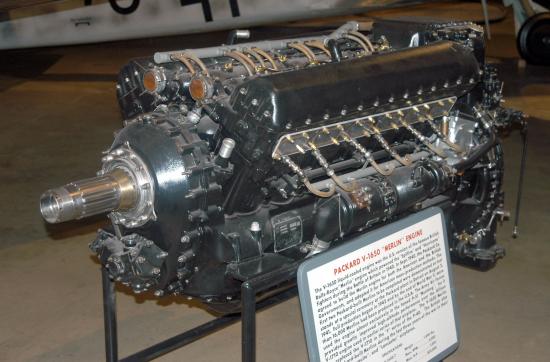
Packard V-1650 Merlin
(source : National Museum of the U.S.A.F. - Photo USAF - Domaine public - Picture U.S.A.F. - Public domain)
De plus, il était en métal et donc réutilisable par les allemands. Il fut donc créé un bidon de 409 litres en papier collé en couches ; au contact de l'essence, ce bidon se dégradait au bout de huit heures ce qui n'était pas un problème, celui-ci étant largué au bout de quatre heures. Certains pilotes utilisèrent ce bidon comme une bombe incendiaire (type bombe au napalm). 48 000 de ces bidons furent fabriqués.
Moreover, it was made of metal and thus reusable by the Germans. It was then created a tank of 409 liters made of paper stuck in layers ; in contact with the gasoline, this tank was degraded after eight hours which was not a problem, this tank being dropped after four hours. Some pilots used this tank as a bomb flamer (similar to a bomb with napalm). 48,000 of these tanks were manufactured.
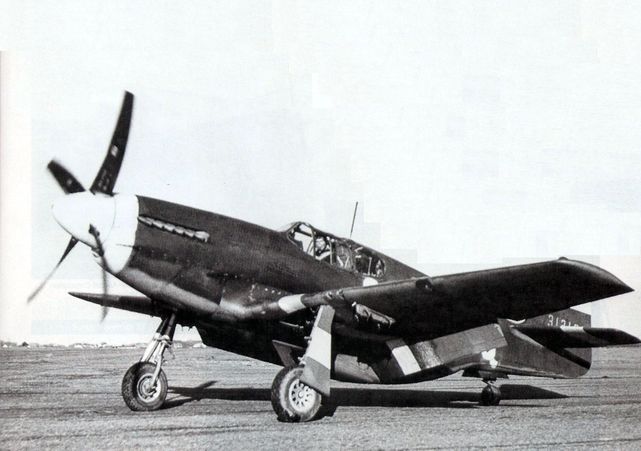
Mustang P-51B-1-NA (43-12198), 4th FG puis/then 356th FG
appareil converti en biplace localement en Grande-Bretagne
aircraft converted in two-seater locally in Great-Britain
Photo USAF - Domaine public - Public domain
P-51C (& Mustang III)
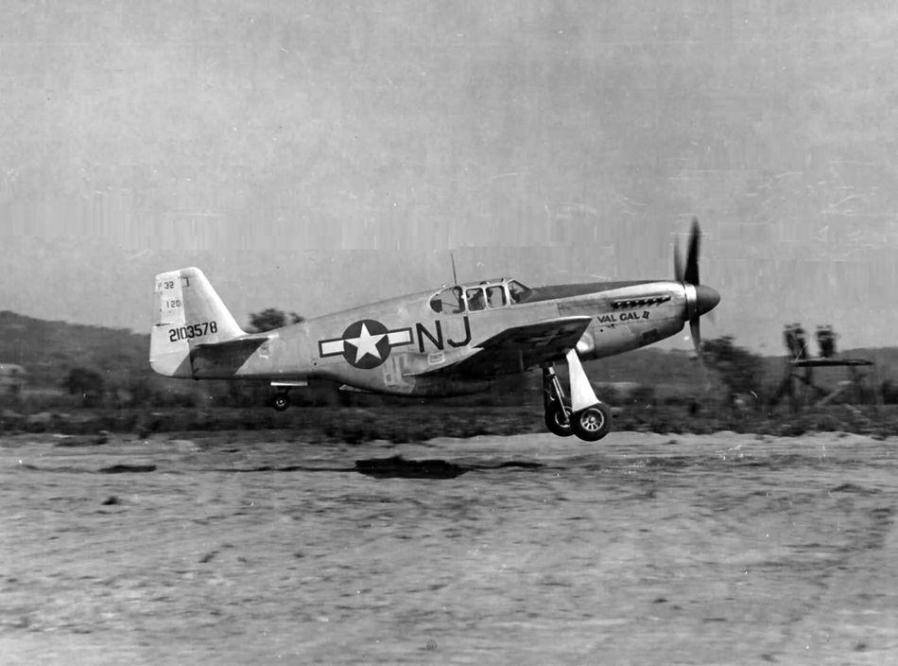
Mustang P-51C-5-NT (42-103578), “Val Gal II” 111th TRS, Lt Stanley F Fierstein
Photo USAF - Domaine public - Public domain
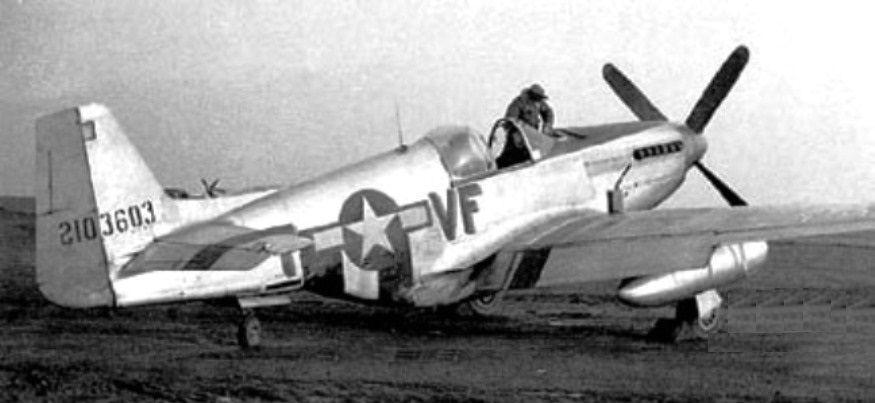
Mustang P-51C-7-NA (s/n 42-103603), 336thFS, 4thFG, 8thAF
Photo UPL 20900 © IWM - www.americanairmuseum.com
Le P-51C-NT était identique au P-51B-NA mais il était fabriqué dans l'usine North American de Dallas, Texas (N pour North American et T pour Texas). 1750 avions furent fabriqués demi-1943 à mi-1944. Sur les 1750, 636 furent livrés à la RAF sous le nom Mustang III et 20 autres furent équipés de caméras K-24 et baptisés F-6C pour l'U.S.A.A.F.
The P-51C-NT was similar to the P-51B-NA but was manufactured in the factory North American in Dallas, Texas (N for North American and T for Texas). 1,750 planes were manufactured from mid-1943 to mid-1944. On the 1,750, 636 were delivered to the RAF under the name Mustang III and 20 others were equipped with cameras K-24 and named F-6C for the U.S.A.A.F.
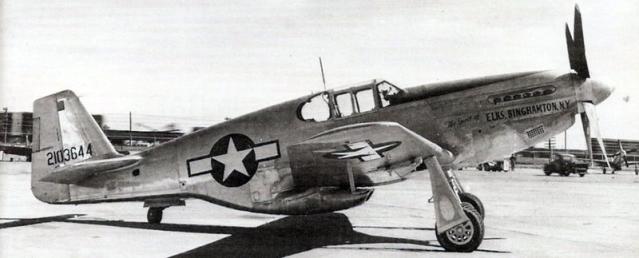
Mustang P-51C-5-NT (42-103644)
Le nom des deux villes ayant souscrit en bons d'achat est inscrit sur le capot
The name of both cities that subscribed in war bondsis written on the hood
Photo USAF - Domaine public - Public domain
La production fut réparties en lots -1, -5, -10 et -11. Les 350 premiers modèles furent équipés du Packard (Merlin) V-1650-3 et tous les suivants du V-1650-7. Un réservoir de fuselage fut ajouté sur des P-51C-1 qui furent ainsi renommés P-51C-3NT.
The production was divided into lots -1, -5, -10 and -11. The first 350 models were equipped with Packard (Merlin) V-1650-3 and all the following units with the V-1650-7. A fuselage tank was added to P-51C-1s which were then renamed P-51C-3NT.
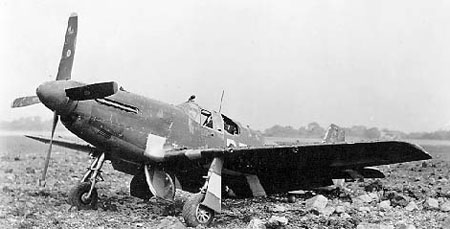
P-51C - après une explosion proche - after nearby explosion
(source : National Museum of the U.S.A.F. - Photo USAF - Domaine public - Picture U.S.A.F. - Public domain)
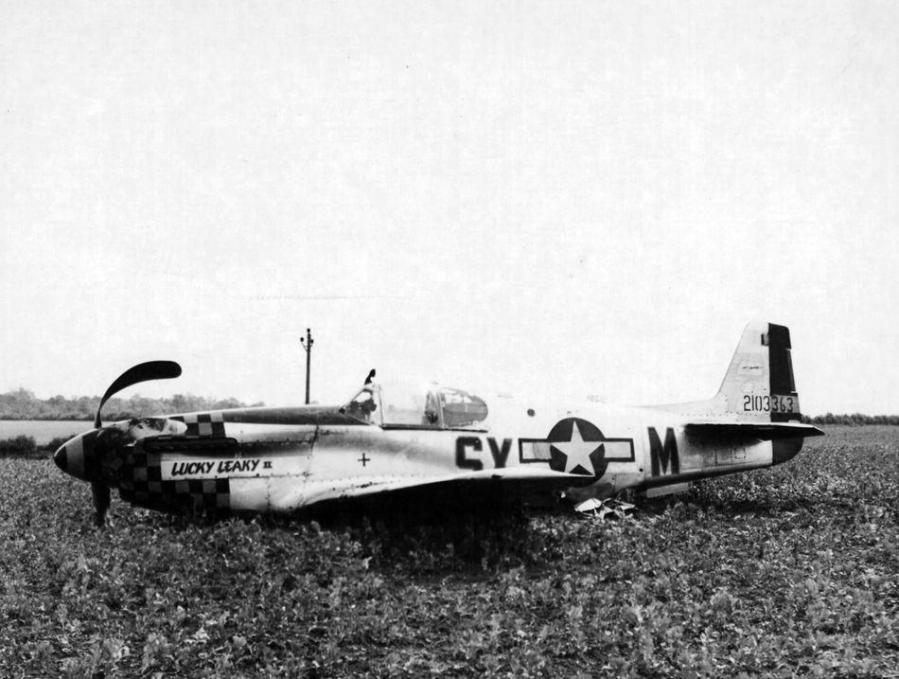
Mustang P-51C-5-NT (42-103363) 'Lucky Leaky II', Lt. John E. Davenport
Tombé en panne le 2 mai 1945 après que son pilote, Lt. Leroy O. Pletz, eut changé de réservoir de carburant et coupé le moteur.
It came to grief on 2nd May, 1945 ,after its pilot Lt. Leroy O. Pletz switched fuel tanks and the engine cut.
Photo UPL 23668 © IWM - www.americanairmuseum.com
P-51D
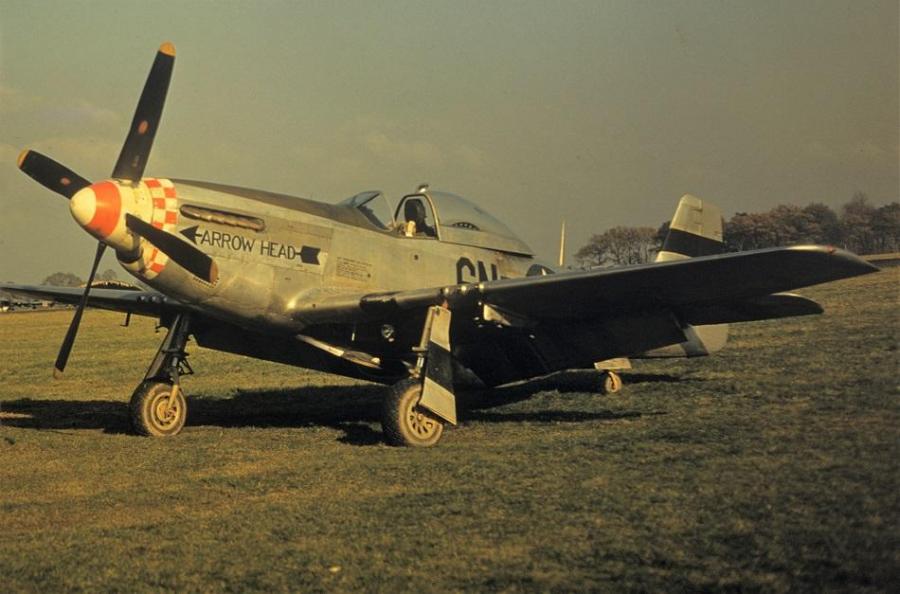
Mustang P-51D-10-NA '6N-O' - (s/n 44-14776) - 505th FS
Photo Robert Astrella - FRE 5955 © IWM - www.americanairmuseum.com
Les rapports des pilotes utilisant les P-51B et C mettaient en avant le manque de visibilité vers l'arrière et l'U.S.A.A.F. demanda à North American d'étudier l'adaptation d'une verrière bulle. 2 exemplaires de P-51B-1-NA (rebaptisés NA-106) furent prélevés pour recevoir la canopée-bulle montée sur les dernières versions du Hawker Typhoon et devinrent les prototypes du P-51D.
The reports of the pilots using the P-51B and C were pointing out the lack of backward visibility and the U.S.A.A.F. asked North American to adapt a new bubble canopy. 2 units of P-51B-1-NA (renamed NA-106) were taken to receive the bubble-canopy which was fitted on the last versions of the Hawker Typhoon and became the prototypes of the P-51D.
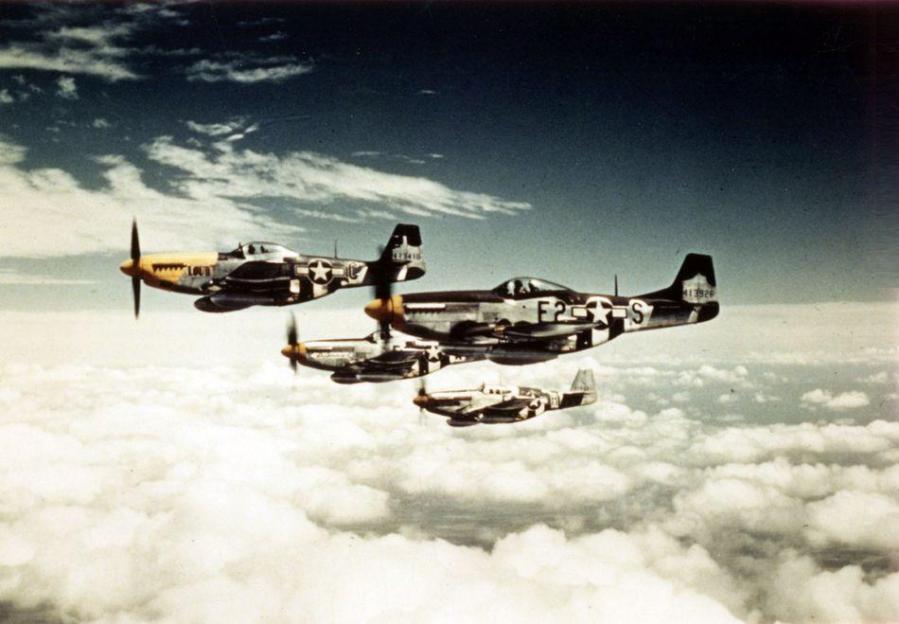
Mustang P-51D - 361st FG (E2-C, s/n 44-13410) "Lou IV (Athelene)", (E2-A, s/n 44-13568) "Sky Bouncer", (E2-S, s/n 44-13926) & (E2-H, s/n 42-106811) "Suzie G"
Photo FRE 527 © IWM - www.americanairmuseum.com
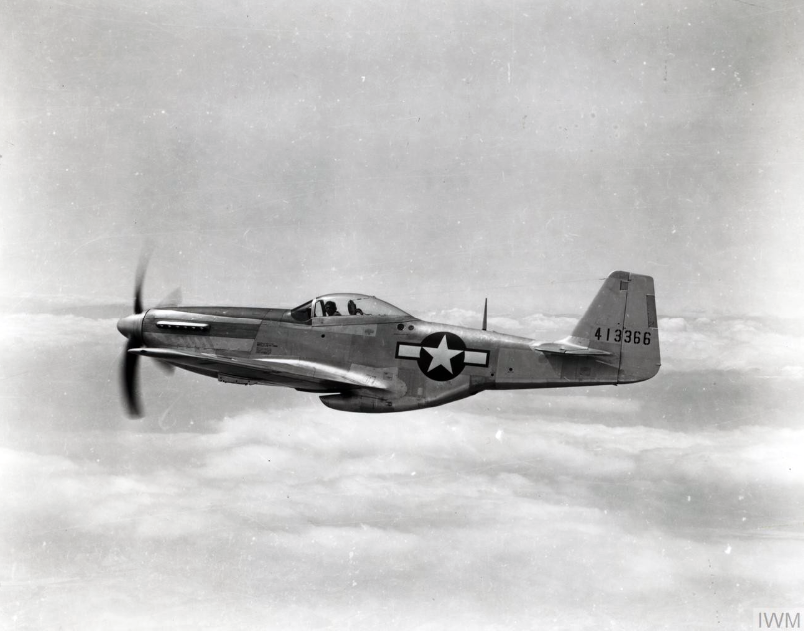
Mustang P-51D-5-NA (44-13366)
Photo © IWM FRE 12415 - www.americanairmuseum.com
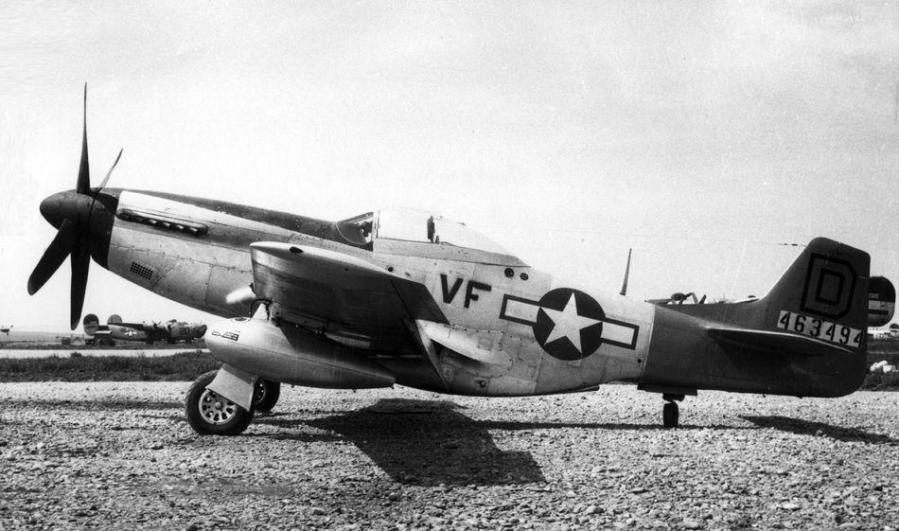
Mustang P-51D-20-NA (s/n 44-63494) - 5th FS, 52nd FG, 49th Wing, 15th AF -Madna, Italie/Italy, printemps/spring 1945
Photos FRE 8688 © IWM - www.americanairmuseum.com
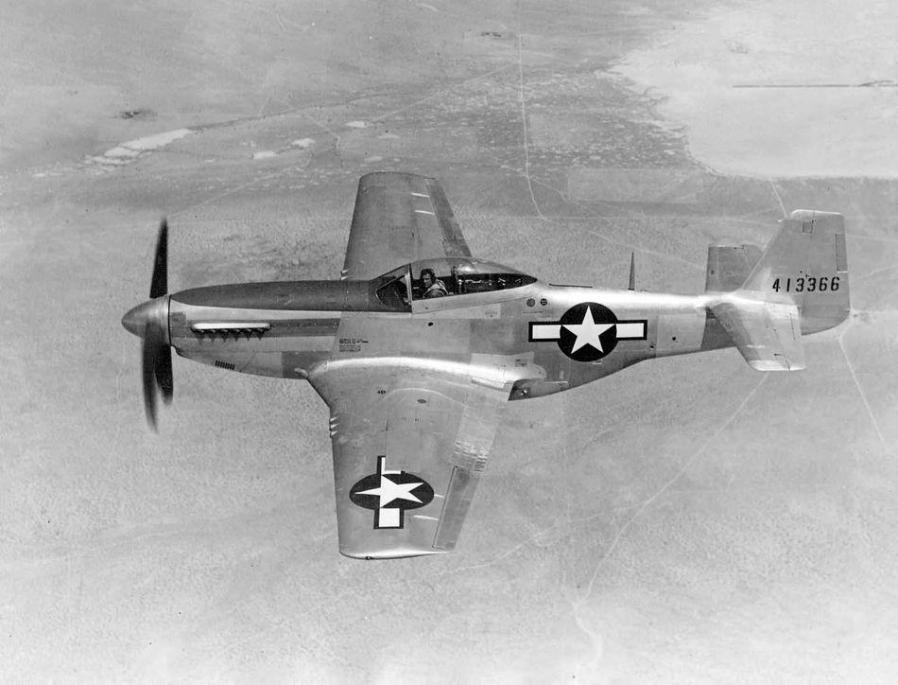
Mustang P-51D-5-NA (s/n 44-13366)
Vol test près de l'usine d'Inglewood - Test flight near the plant at Inglewood
Photos UPL 21329 © IWM - www.americanairmuseum.com
Mais les véritables 1ers essais d'une verrière bulle furent effectués fin 1943 sur le P-51 B n° 43-12102 ; celui-ci conserva son appellation P-51B, l'appellation P-51 D n'étant adpotée qu'à l'issue de l'ensemble des modifications.
But the original 1st tests of a bubble canopy started late 1943 with the P-51 B n°43-12102 ; this unit kept its name P-51 B, the name P-51 D being really adopted when all modifications were performed.
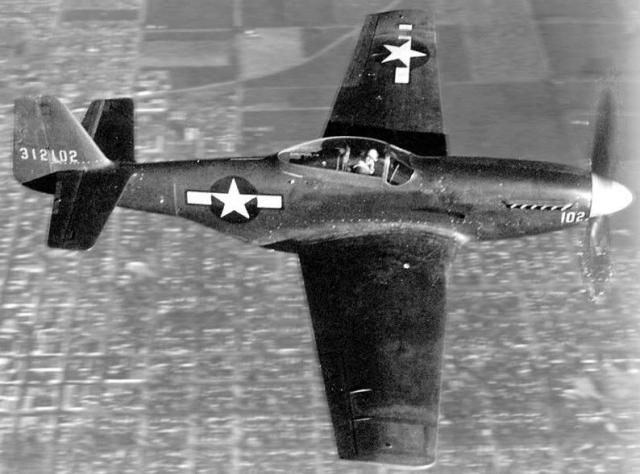
P-51 B-1-NA (s/n 43-12102) - Le 1er prototype à verrière bulle - The 1st bubble canopy prototype
(Photo USAF : Domaine public - Public domain)
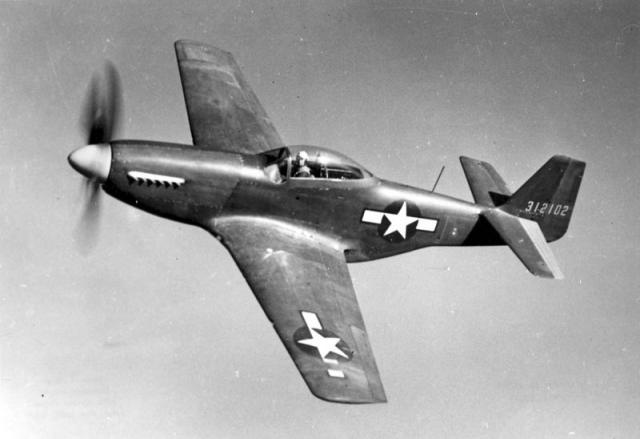
Prototype P-51D (s/n 43-12102)
(source : National Museum of the U.S.A.F. - Photo USAF : Domaine public - Public domain)
D'autres modifications furent apportées : le pare-brise, un longeron dorsal fut ajouté (pour améliorer la stabilité directionnelle - cette amélioration fut également faite à quelques P-51B/C), l'emplanture de l'aile agrandie, un réservoir de 322 litres derrière l'habitacle. L'armement d'ailes passa de 4 à 6 mitrailleuses Browning de 0.50, toutes dans les ailes. Le moteur fut le Packard V-1650-7.
Other modifications were made : the windscreen, a dorsal fillet added (to improve the directional stability - this improvement was retrofitted on some P-51B/C), the base of the wing enlarged, a tank of 322 liters behind the cockpit. The wing armament switched from 4 to 6 Browning 0.50 machine-guns, all fitted in the wings. The engine was the Packard V-1650-7.
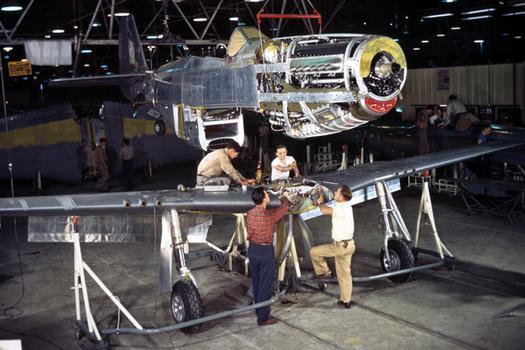
Assemblage d'un P-51D à Inglewood - P-51D assembly at Inglewood
(source : USAF - Domaine public - Public domain)
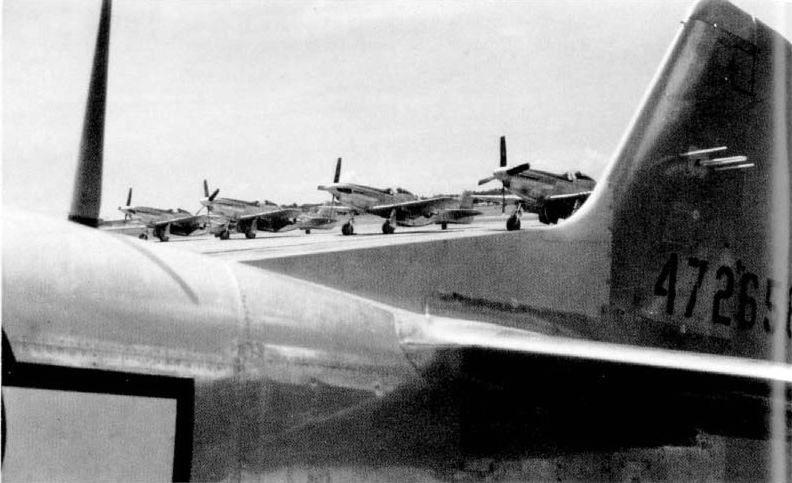
Mustang P-51D-25
Antenne radar alerte de queue APS-13 - APS-13 tail warning radar antenna
Photo USAF (Domaine public - Public domain)
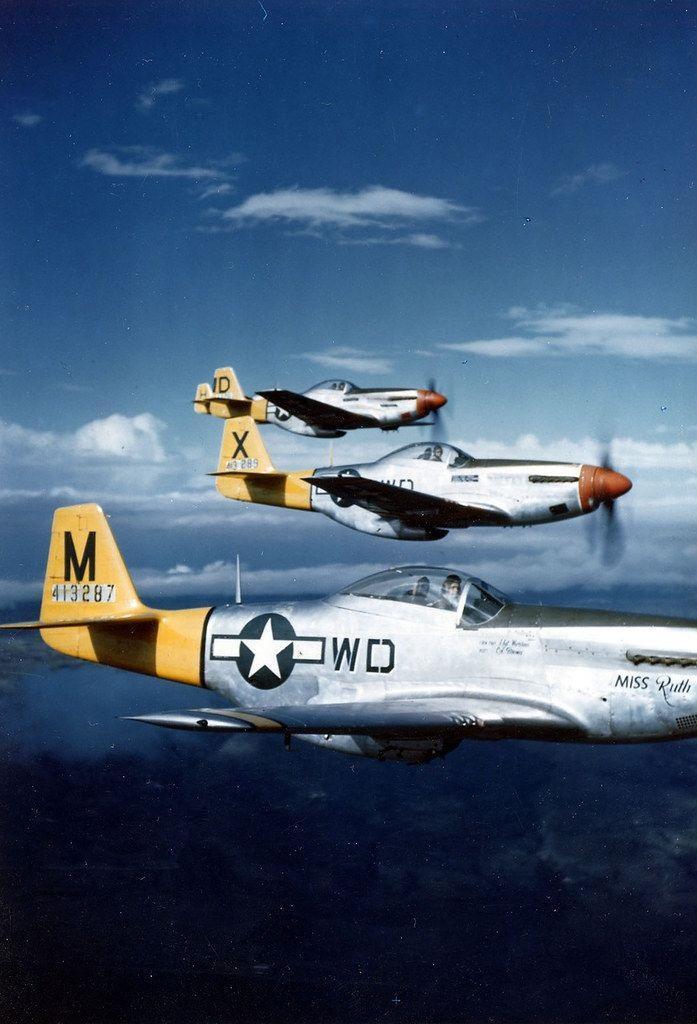
Mustang P-51D WD-M “Miss Ruth” (s/n 44-13287) & WD-D "Jo-Baby..." (s/n 44-13263) - 4th FS, 52nd FG.
Photo USAF (Domaine public - Public domain)
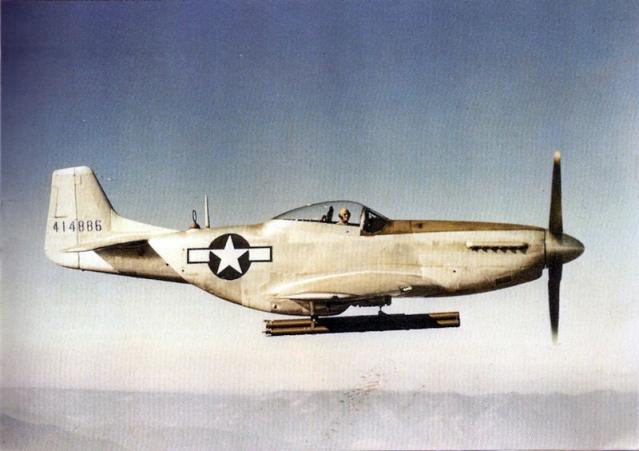
Mustang P-51D (s/n 44-14886)
(source : USAF - Domaine public - Public domain)

Mustang P-51D - 55th FG, Debden, Juin/June 1945
USAF - Domaine public - Public domain
6 504 avions furent fabriqués à Inglewood à partir de février 1944 (P-51D-1-NA à P-51D-305-NA) et 1 600 à Dallas à partir de juillet (P-51D-5-NT à P-51D-30-NT).
6,504 planes were manufactured in Inglewood from February 1944 (P-51D-1-NA to P-51D-30-NA) and 1,600 in Dallas from July (P-51D-5-NT to P-51D-30-NT).

P-51D
Florene Watson (Women Airforce Service Pilots) prépare l'avion pour son vol de livraison à Inglewood
Florene Watson (Women Airforce Service Pilots) preparing the plane for a ferry flight from the factory at Inglewood
(source : USAF - Domaine public - Public domain)
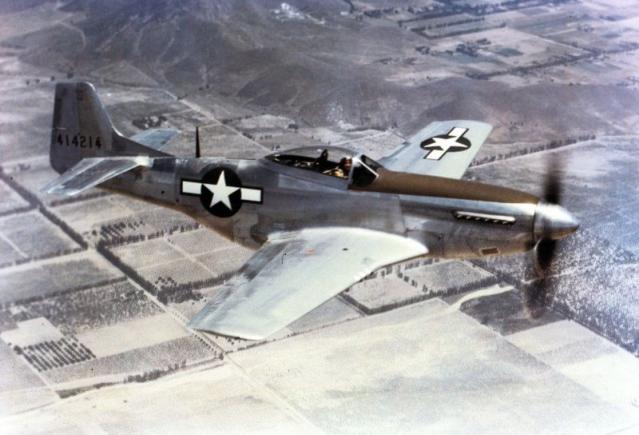
Mustang P-51D-10-NA (s/n 44-14214)
(source : USAF - Domaine public - Public domain)
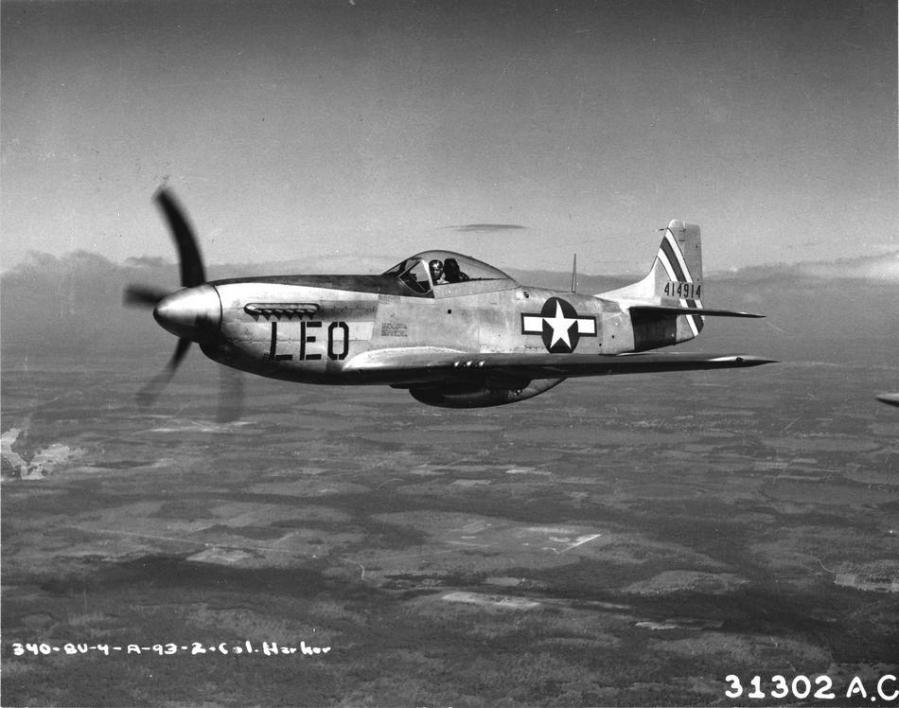
Mustang P-51D (s/n 44-14914) - Colonel Ward W. Harker, CO 54th FG, Bartow Field, Floride/Florida, 1944
Photo : USAF 31302 AC (Domaine public - Public domain)
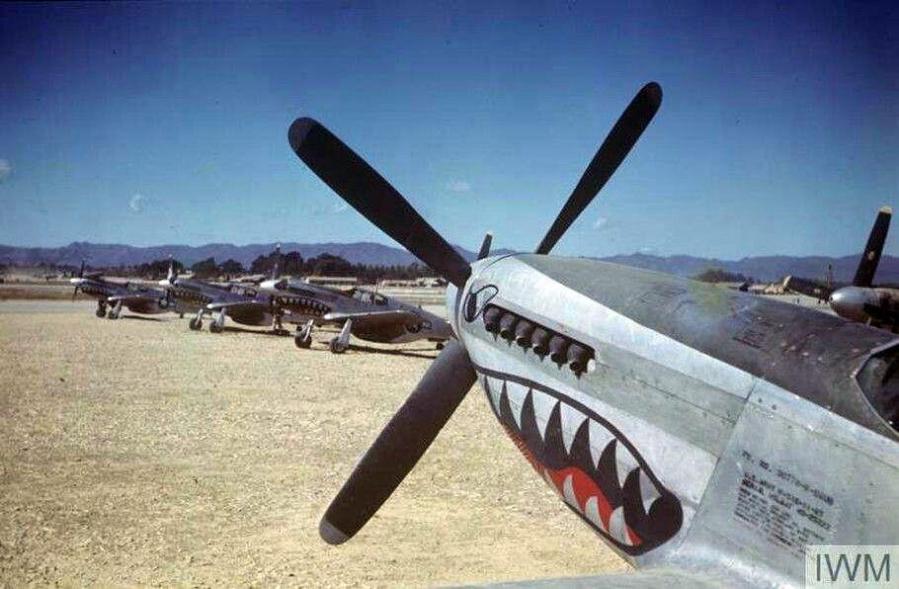 Mustang P-51D (s/n 43-25222) 23rd FG & P-51D 51st FG Chine/China
Mustang P-51D (s/n 43-25222) 23rd FG & P-51D 51st FG Chine/China
Photo : Imperial War Museum
136 P-51D furent modifiés pour la reconnaissance et appelés F-6D-20/25/30-NT. Il semblerait que quelques P-51D-5-NA aient été également transformés en F-6D-5-NA (cf photo ci-dessous). 281 P-51 D furent envoyés à la RAF sous le nom Mustang Mk IV.
136 P-51D were modified for reconnaissance and were called F-6D-20/25/30-NT. It seems that some P-51D-5-NA were also transformed into F-6D-5-NA (see photo below). 281 P-51 D were sent to the RAF under the name Mustang Mk IV.
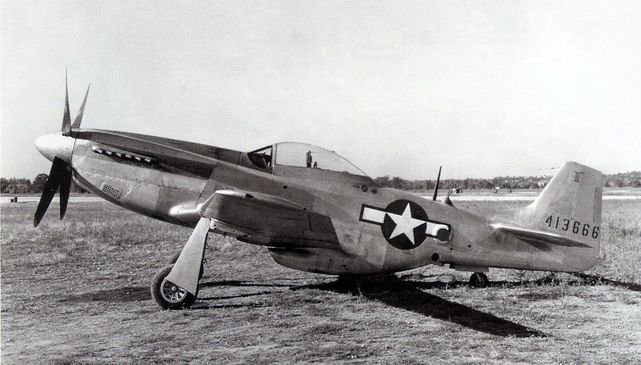
Mustang F-6D-5-NA (s/n 44-13666)
Photo USAF - Domaine public - Public domain
Des P-51 B et P-51 D ayant été transormés arbitrairement en unités pour être en double commande, l'Armée demanda que 15 modèles soient développés : ils furent fabriqués à l'usine de Dallas sous le nom de TP-51D-25-NT.
Some P-51 Bs and P-51 Ds being arbitrarily transformed "in the field" in dual control aircrafts, the Army required 15 models to be developed : they were manufactured at the Dallas factory under the name TP-51D-25-NT.

TP-51 D (s/n 44-84662)
(source inconnue, probablement U.S.A.F. ou N.A.A. - Source unknown, probably U.S.A.F. or N.A.A.)
Les pilotes de P-51D bénéficièrent également de 2 innovations : le viseur gyroscopique K-14 et la combinaison anti-G. Le K-14 apportait une plus grande précision de tir lors des combats à grande vitesse. Deux modèles de combinaison anti-G existèrent : un modèle anglais (Franck) lourde et inconfortable et un modèle américain (Berger) beaucoup plus appréciée des pilotes.
The pilots of P-51D also had the chance to discover 2 innovations : the gyroscopic gun sight K-14 and the anti-G suit. The K-14 gave a highher degree of accuracy when shooting during high speed dog fight. Two models of anti-G suits existed : an English model (Franck) heavy and uncomfortable and an American model (Berger) much more appreciated by the pilots.
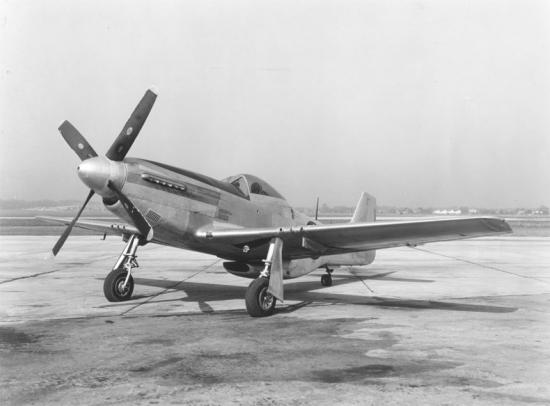
P-51D (source : USAF - Domaine public - Public domain)
L'US Navy testa un P-51 D-5-NA (s/n 44-14017 rebaptisé ETF-51 D) dont la structure fut renforcée et une crosse d'appontage ajoutée. En septembre 1944, le pilote d'essai, le Lieutenant Robert M. Elder effectuait les premiers essais à la base navale de Mustin Field, près de Philadelphie.
The US Navy tested a P-51 D-5-NA (s/n 44-14017 redesignated ETF-51 D) of which the structure was reinforced and a tailhook added. In September 1944, the test pilot, the Lieutenant Robert M. "Bob" Elder performed the first tests in the naval base of Mustin Field, near Philadelphia.
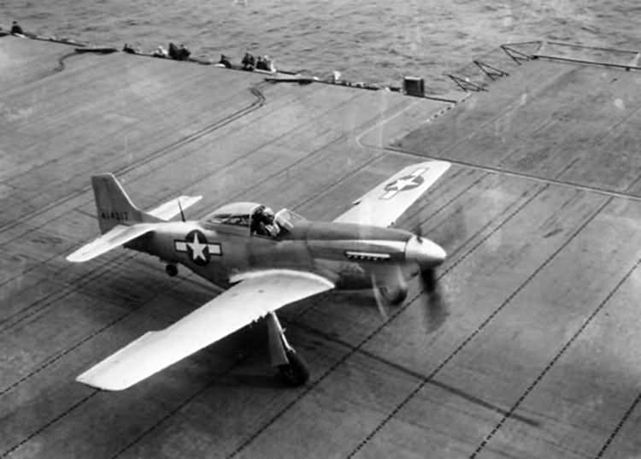
P-51 D-5-NA (s/n 44-14017) - Lt R.M. Elder, USS Shangri-La (CV-38), novembre/November 1944
© US Navy (domaine public - public domain)
Le 13 novembre 1944, "Bob" Elder appontait sur le Shangri-La (CV-38) au large de Norfolk. 4 catapultages et 3 appontages suivirent avec succès. Après 25 décollages et atterrissages, l'avion fut renvoyé à la base navale de Mustin Field et on n'entendit plus parler de lui. Cet avion a peut-être reçu le BuNo 57987 (non confirmé).
On November 13th, 1944, l"Bob" Elder anded on the Shangri-La (CV-38) near Norfolk. 4 takeoffs and 3 landings followed successfully. After 25 takeoffs and landings, the plane was sent back to Mustin Field and nobody did any more hear about it. This aircraft could have get the BuNo 57987 (not confirmed).
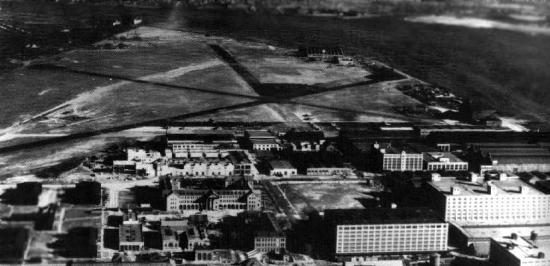
Mustin Field Naval base 1943 - © US Navy (domaine public - public domain)
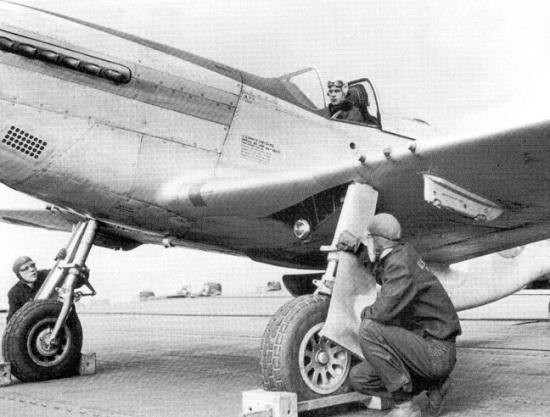
P-51 D-5-NA (s/n 44-14017) - Bob Elder est aux commandes - Bob Elder is in the plane
© US Navy (domaine public - public domain)

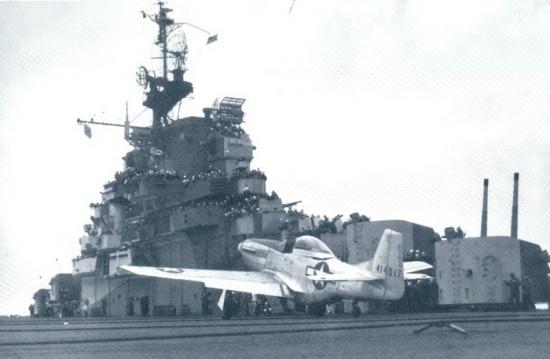
P-51 D-5-NA (s/n 44-14017) - Sur le pont de l'USS Shangri-La - On the deck of USS Shangri-La
© US Navy (domaine public - public domain)
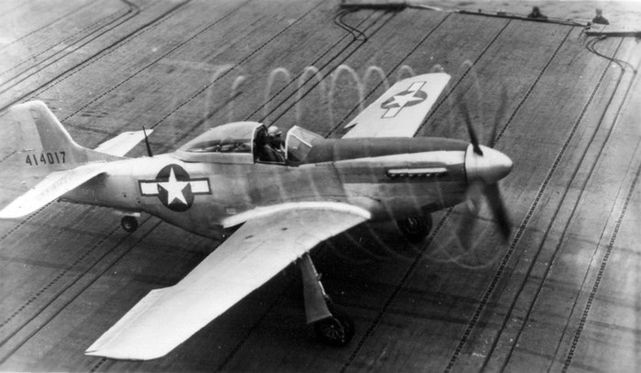
P-51 D-5-NA (s/n 44-14017) - Sur l'USS Shangri-La - On the USS Shangri-La
© US Navy (domaine public - public domain)

P-51 D-30-NT (s/n 45-11730 ?) L'un des derniers Mustang produits - One of the last manufactured Mustang
© San Diego Air & Space Museum
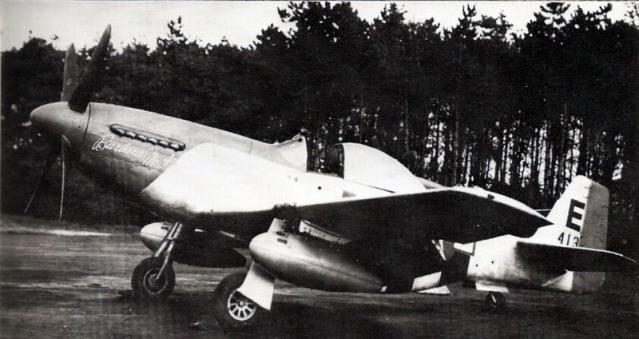
P-51 D-5 (s/n 44-13406) Barbara M 4th, Lt Col. John 'Curly' Edwards 328th FS 352nd FG
© USAF (domaine public - public domain)
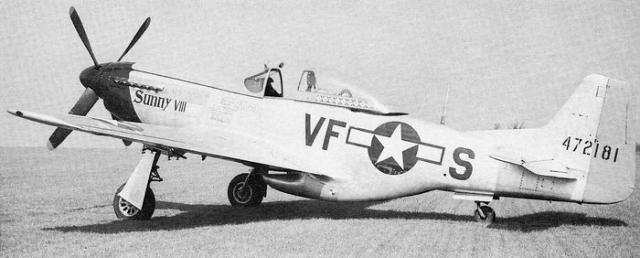
P-51 D-20-NA (s/n 44-72181) Sunny VII, Colonel Everett Stewart( C.O. of 4th FG), 336th FS 4th FG, Debden
Crashé par mauvais temps, pendant son transfert de Debden à Speke, à Castleshaw Moor, le 29 mai 1945.
Le pilote, le Lt. Harold H Frederick fut tué.
Crashed due to weather, while being ferried from Debden to Speke, at Castleshaw Moor, on Mai 29th, 1945
The pilot, Lt Harold H Frederick, was killed.
Photos UPL 14916 © IWM - www.americanairmuseum.com

P-51 D-10-NA (s/n 44-14190) 'Denver Belle', Capt. J. A. Walker - 384th FS, 364th FG - Honington
Accidenté en bout d'aile au roulage - Damaged at wing tip during taxiing accident.
Photos USAF (domaine public - public domain) NARA 342-FH-3A05701-72287AC
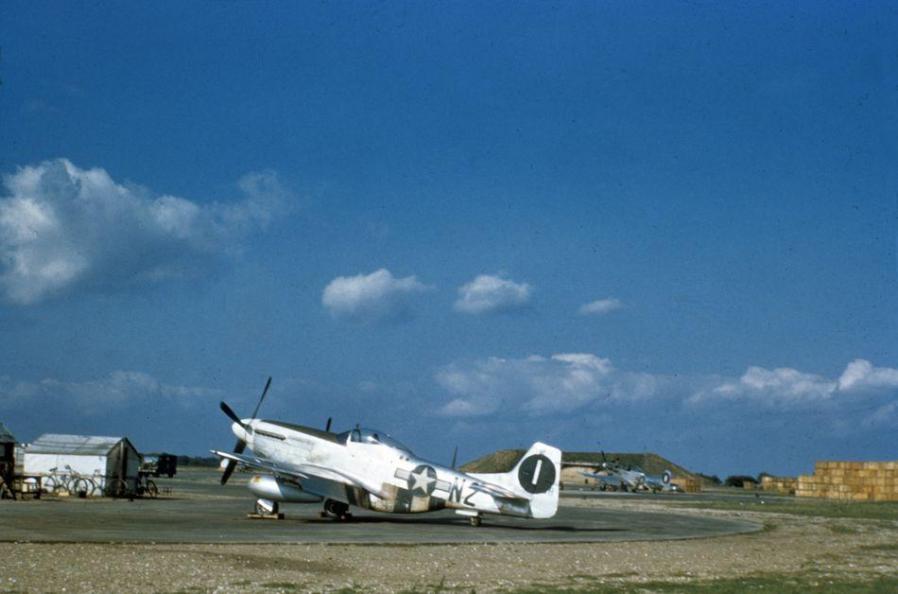
Mustang P-51D (s/n 42-103603), 336thFS, 364thFG, Honington, 1944
Photo FRE 6214 © IWM - www.americanairmuseum.com
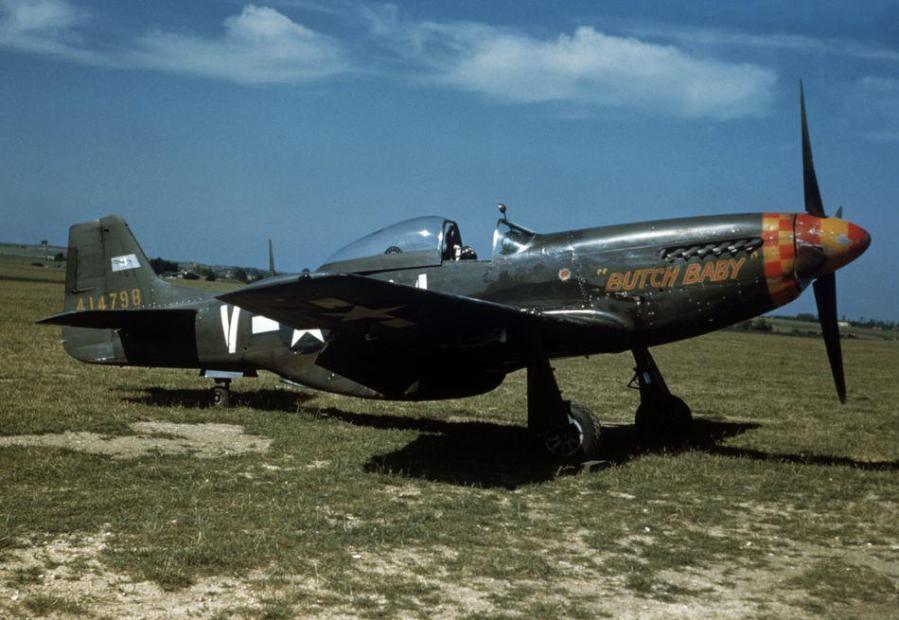
Mustang P-51D-10-NA (s/n 44-14798) 'Butch Baby', 357th FG, Steeple Morden
Photo FRE 6093 © IWM - www.americanairmuseum.com
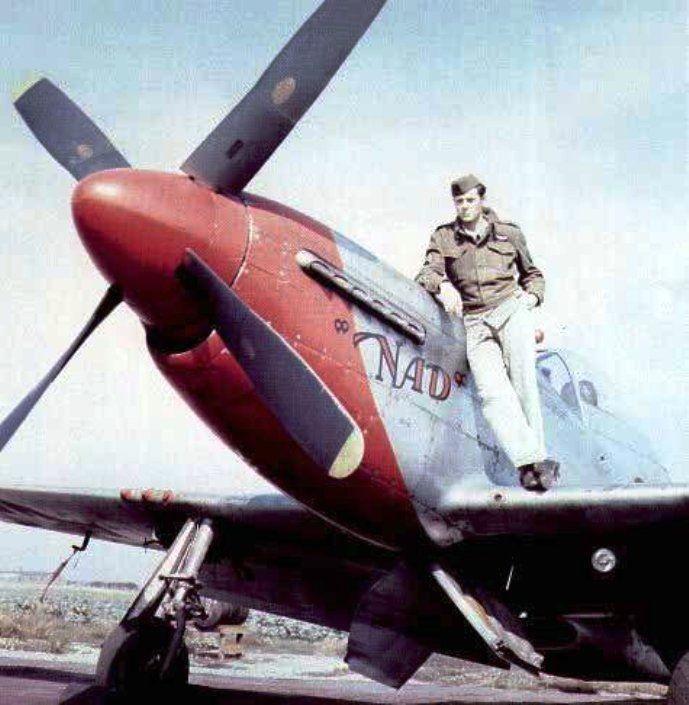
Mustang P-51D-10-NA (s/n 44-14518) 'Nad' 334th FS, 4th FG, 8th AF, 2nd Lt Calvin H Beason
Photo UPL 21107 © IWM - www.americanairmuseum.com
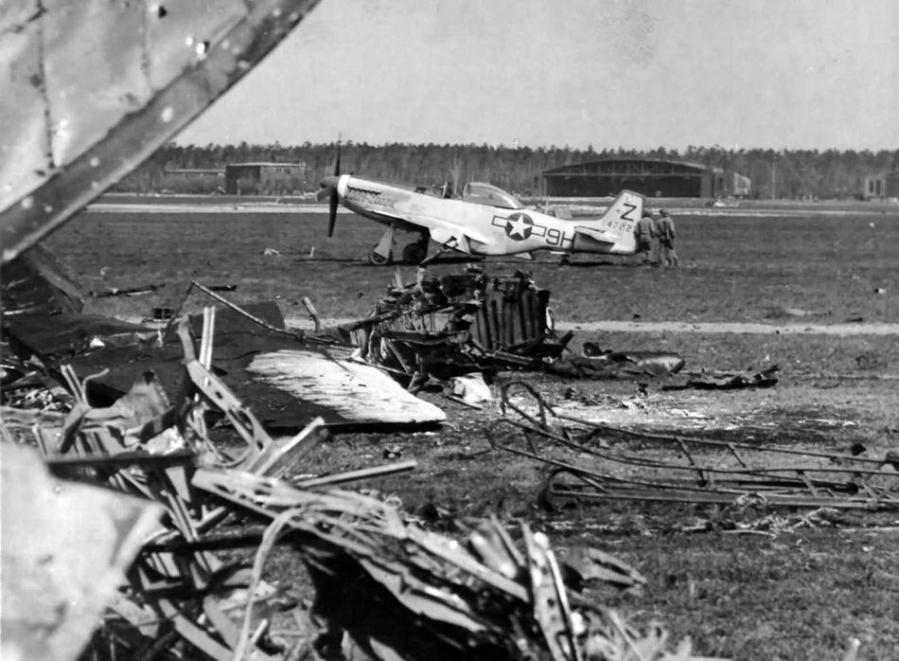
P-51 D-20-NA (s/n 44-72239), 1st Scouting Force 'Zoom-Zoozie' - Capt. John Simpson - Polzen, Allemagne/Germany.
Photos USAF (domaine public - public domain) NARA 342-FH-3A19732-94587AC
P-51F
Au fil des évolutions du P-51, le poids de l'appareil était devenu important. L'U.S.A.A.F. fit donc étudié un modèle plus léger qui s'appela XP-51F. La structure et la voilure furent allégées, la dimension du train réduite et on utilisa ce nouveau matériau appelé plastique.
With the diffrent evolutions of P-51, the weight of the aircraft became important. The U.S.A.A.F then required a lighter model to be studied which was called XP-51F. The structure and the wings were reduced in weight, the landing gear also and a new material called plastic was used.
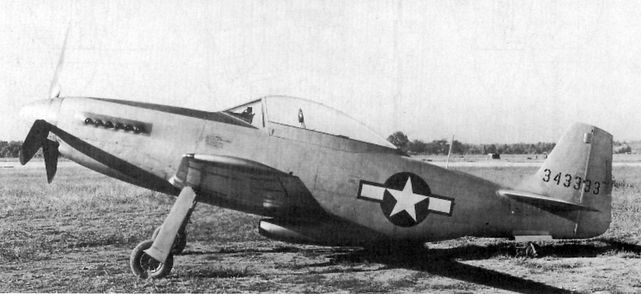
Mustang XP-51F (s/n 43-43333), second prototype
Picture with courtesy of Australian War Memorial (http://www.awm.gov.au)
Le nombre de mitrailleuses revint à 4. Le réservoir derrière le pilote disparut. L'hélice quadripale Hamilton-Standard céda la place à une tripale Aeroproducts. Le moteur fut le V-1650-3 (mais une autre source indique V-1650-7)
The number of machine-guns came back to 4. The tank behind the pilot disappeared. The four-bladed propeller Hamilton-Standard was replaced by a three-bladed propeller Aeroproducts. The engine was the V-1650-3 (but another source indicates V-1650-7).
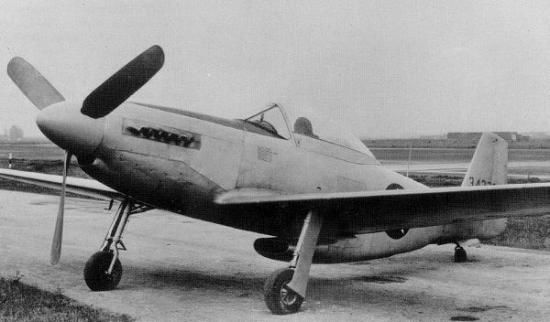
XP-51F (s/n 43-43332 ou/or 43-43334)
(source : National Museum of the U.S.A.F. - Photo USAF - Domaine public - Picture U.S.A.F. - Public domain)
Le prototype du XP-51F (NA-105), plus léger de 680 kg, vola le 14 février 1944 et sa vitesse fut supérieure d'environ 40 km/h (750 km/h à 7500 m). Mais il était relativement instable. Les 2nd et 3ème prototypes volèrent les 20 et 22 mai 1944.
The prototype of XP-51F (NA-105), lighter by 680 kg, flew on February 14th, 1944 and its speed was higher by around 40 km/h (750 km/h at 7,500 m). But it was relatively unstable. The 2nd and 3rd prototypes flew on May 20th and 22nd 1944.
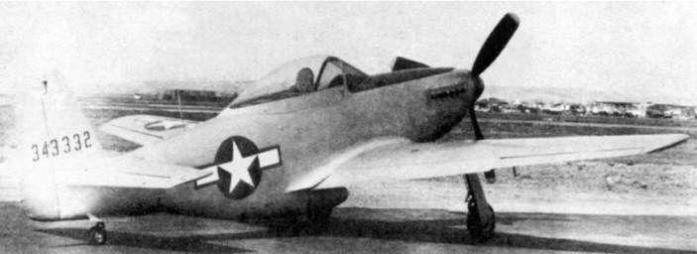
Mustang XP-51F (s/n 43-43332)
© North American Aviation
Ce dernier fut prêté aux Anglais pour évaluation. 2 autres prototypes commandés par l'U.S.A.A.F. furent équipés d'un moteur Rolls-Royce RM 14SM : ils furent nommés XP-51G.
The last one was lent to the English for evaluation. 2 other prototypes ordered by the U.S.A.A.F were fitted with an engine Rolls-Royce RM 14SM : they were named XP-51G.
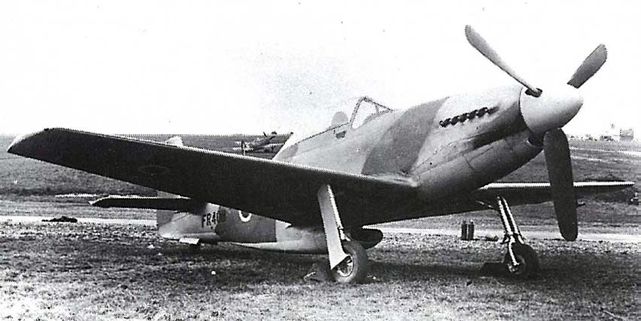
Mustang XP-51F FR409 (s/n 43-43335), 3e prototype
© RAF Museum
P-51G
Le XP-51G (NA-105) était identique au XP-51F mais avec un moteur Merlin RM-14SM plus puissant et une hélice à cinq pales. Il vola le 9 août 1944. Ces essais furent très satisfaisants (760 km/h à 7500 m) au mais l'insuffisance de production du nouveau moteur entraîna l'arrêt du projet.
The XP-51G (NA-105) was similar to the XP-51F but with an engine Merlin RM-14SM more powerful and a five blades propeller. It flew on August 9th, 1944. These tests were very satisfactory (760 km/h at 7,500 m) but the insufficiency of production of the new engine led to the end of the project.
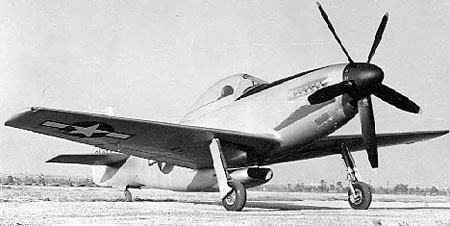
XP-51G
(source : National Museum of the U.S.A.F. - Photo USAF - Domaine public - Picture U.S.A.F. - Public domain)
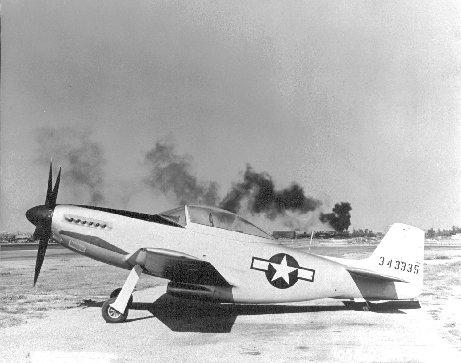
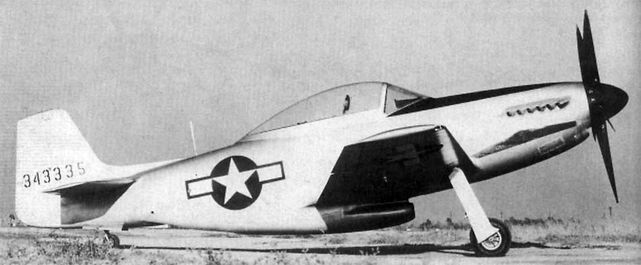
XP-51 G (s/n 43-43335)
(source inconnue, probablement U.S.A.F. ou N.A.A. - Source unknown, probably U.S.A.F. or N.A.A.)
P-51H

P-51H (s/n 44-64164)
© USAF - Domaine public - Public domain
Le P-51H (NA-126) fut le dernier Mustang fabriqué en série. Il concentrait toutes les innovations des XP-51 F et G. Equipé de 6 mitrailleuses calibre 0.50, il avait le moteur Packard (Merlin) V-1650-9. Le premier vol fut le 3 février 1945 à Mines Field.
The P-51H (NA-126) was the last Mustang manufactured in series. It concentrated all the innovations of the XP-51 F and G. Fitted with 6 machine-guns 0.50, it had the engine Packard (Merlin) V-1650-9. The first flight was on February 3rd, 1945 at Mines Field.
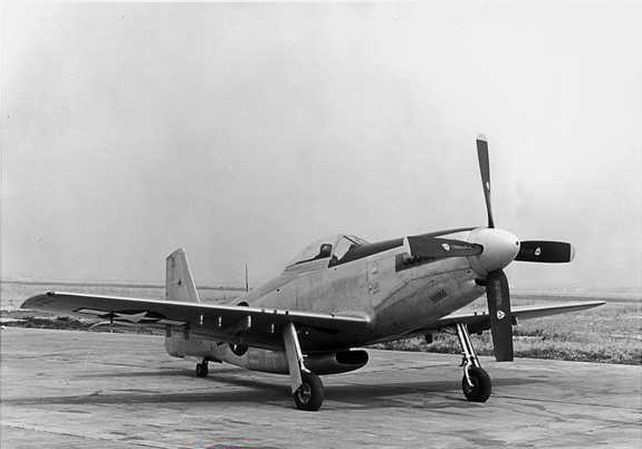
Mustang P-51H - © USAAF - Domaine public - Public domain)
555 modèles furent fabriqués à Inglewood sous 3 lots : P-51H-1-NA (20 exemplaires), -5-NA (280 ex.) et -10-NA (255 ex.). Le P-51 H n'eut pas le temps d'être utilisé outre Atlantique. Une rumeur dit qu'un groupe en aurait été équipé dans le Pacifique mais ce n'est pas confirmé. 370 avions furent livrés à l'Armée avant la fin de la guerre.
555 models were manufactured in Inglewood under 3 lots : P-51H-1-NA (20 units), -5-NA (280 u.) and -10-NA (255 u.). The P-51 H did not have time to be used across the Atlantic ocean. A rumor says that a group used P-51 H in the Pacific area but it is not confirmed. 370 units were delivered to the Army before the end of the war.
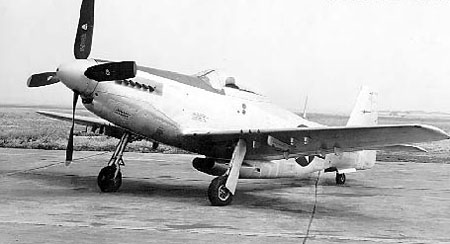
P-51H (s/n 44-64164) - 5ème modèle fabriqué - 5th production model
(source : National Museum of the U.S.A.F. - Photo USAF - Domaine public - Picture U.S.A.F. - Public domain)
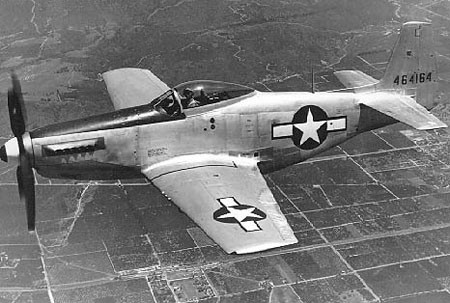
P-51H (s/n 44-64164) - 5ème modèle fabriqué - 5th production model
(source : National Museum of the U.S.A.F. - Photo USAF - Domaine public - Picture U.S.A.F. - Public domain)
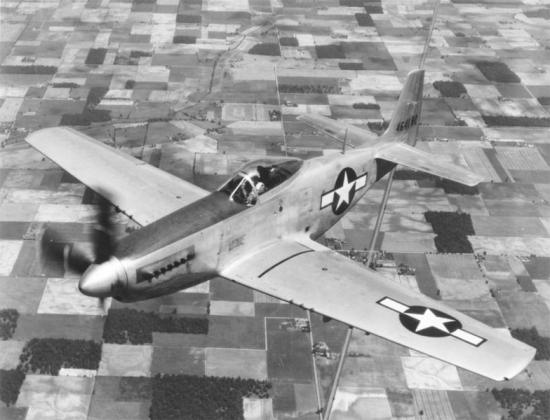
P-51H (s/n 44-644182)
(source : USAF - Domaine public - Public domain)
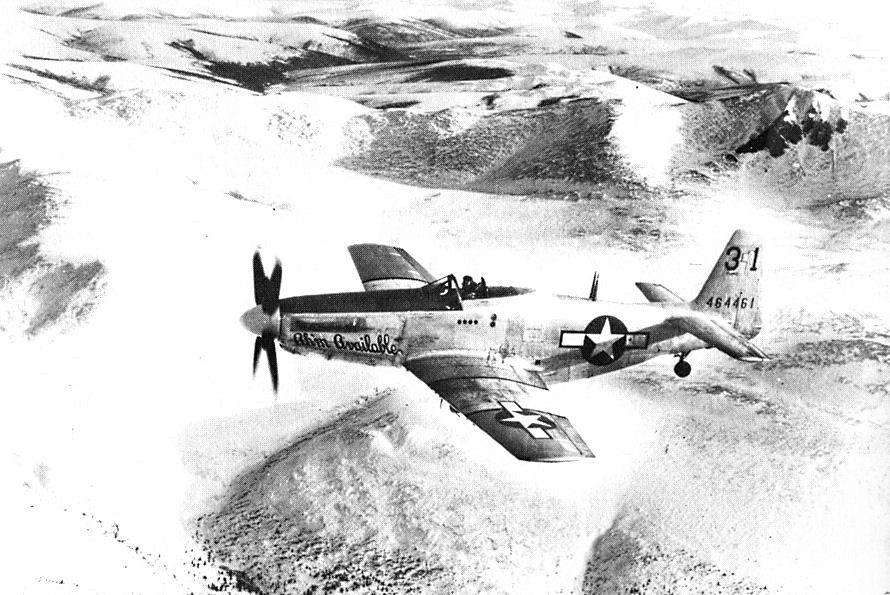
North American P-51H-10-NA Mustang (s/n 44-64461) - Alaskan Air Command, 1946
© USAF - Domaine public - Public domain
P-51J
En même temps que le XP-51F et XP-51G, la N.A.A. développa un prototype équipé du moteur Allison V-1710-119 à injection d'eau, le XP-51J (NA-105). Les deux prototypes portaient les numéros de série 44-76027 et 44-76028. Ils étaient plus long de 23 cm par rapport au XP-51F. Le premier prototype vola le 23 avril 1945. Les essais ne donnèrent pas satisfaction en matière de vitesse et n'atteignit pas les 805 km/h (à 8 200 - 9 100 m) annoncés par la N.A.A.. Le second prototype ne vola pas et fut envoyé chez Allison pour des essais moteurs.
Along with the XP-51F and XP-51G, the N.A.A. developed a prototype equipped with the engine Allison V-1710-119 with water injection, the XP-51J (NA-105). The two prototypes had the serial numbers 44-76027 and 44-76028. They were 23 cm longer than the XP-51F. The first prototype flew on April 23rd, 1945. The tests did not give satisfaction regarding the speed and did not reach 805 km/h (to 8,200 - 9,100 m) announced by the N.A.A. The second prototype did not fly and was shipped to Allison for engine tests.
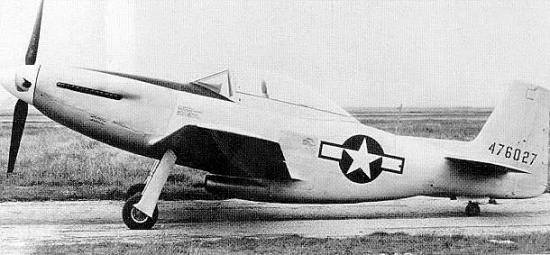
XP-51J (s/n 44-76027) - 1er prototype fabriqué - 1st prototype build
(source : National Museum of the U.S.A.F. - Photo USAF - Domaine public - Picture U.S.A.F. - Public domain)
P-51K
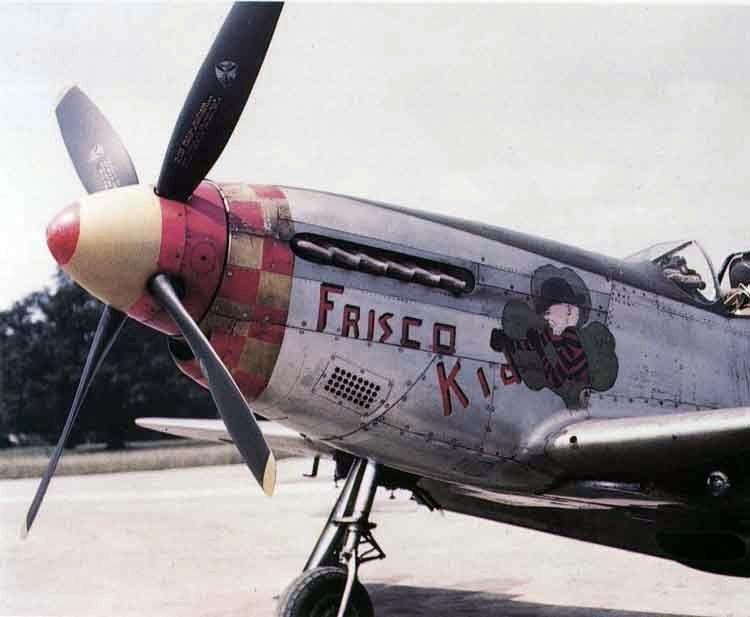
Mustang P-51K, 357th FG, 363rd FS, Lt. John C. Casey
with courtesy http://www.littlefriends.co.uk (Peter Randall)
Très similaire au P-51D, le P-51K bénéficiait des toutes dernières évolutions au niveau de l'équipement radio et de la dérive dorsale et possédait une hélice quadripale Aeroproducts. La verrière bulle fut redessinée pour laisser plus de place à la tête. Les P-51K furent assemblés à Dallas. Cette hélice Aeroproducts fut choisie pour pallier aux difficultés d'approvisionnement d'Hamilton-Standard.
Very similar to the P-51D, the P-51K got the very last evolutions in terms of radio equipment and dorsal tail and had a four-bladed propeller Aeroproducts. The bubble canopy was redesigned for more headroom. The P-51K were assembled in Dallas. This Aeroproducts propeller was selected to anticipate the supply difficulties of Hamilton-Standard.
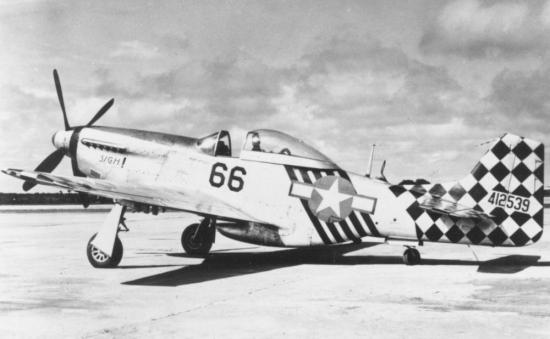
P-51K-NT (s/n 44-12539)
(source : USAF - Domaine public - Public domain)
Mais bien que plus légère de 23 kg, l'Aeroproducts provoquait des vibrations dangereuses d'où des retards de livraisons qui finalement firent que les 1 500 P-51K fabriqués furent équipés d'Hamilton-Standard et rebaptisés P-51D.
But although lighter by 23 kg, the Aeroproducts caused dangerous vibrations and led to delivery delays which finally made that the 1,500 manufactured P-51K were equipped with Hamilton-Standard and renamed P-51D.
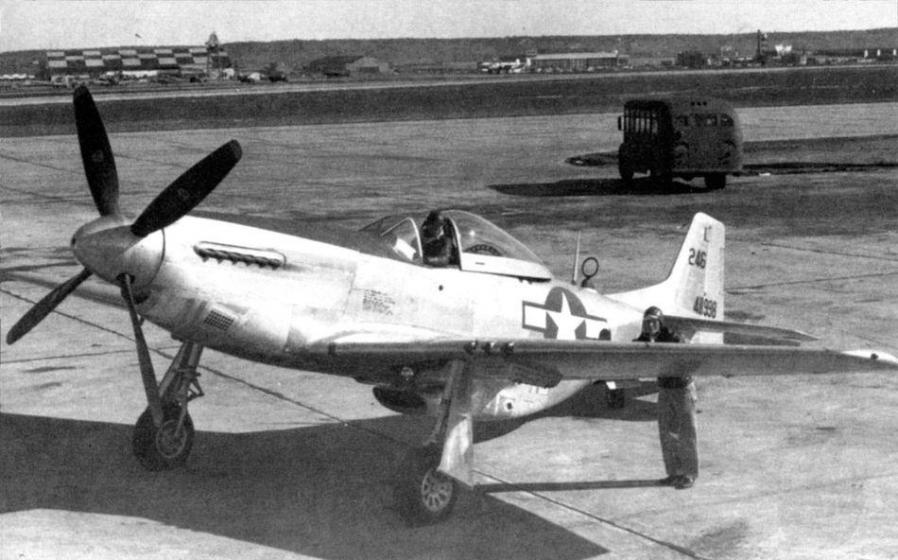
Mustang P-51K-10-NT (F6K-10-NT) (s/n 44-11998)
© North American Aviation
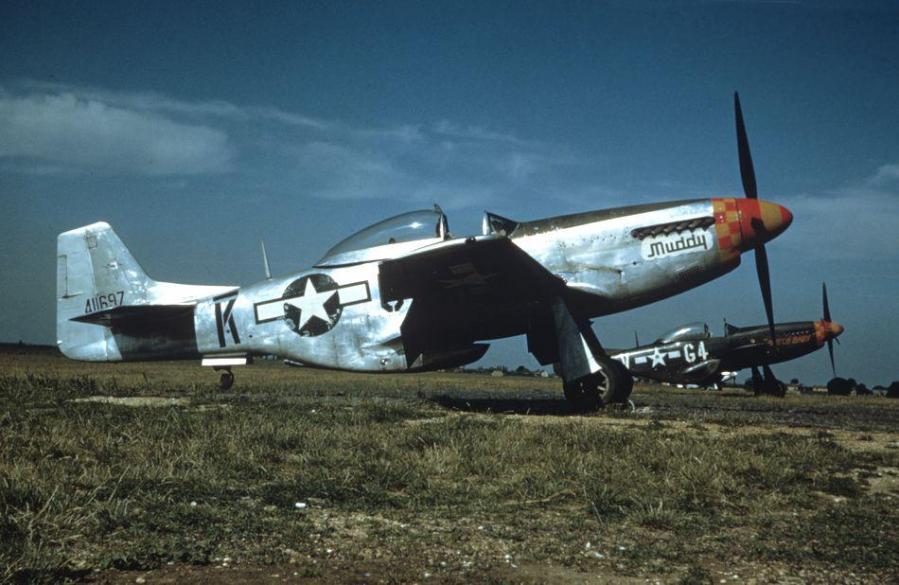
Mustang P-51K-5-NT (s/n 44-11697) 362nd FS, 357th FG, 8th AF
Photo FRE 6102 © IWM - www.americanairmuseum.com
Sur ces 1 500 (s/n 44-11353 à 44-12852), 595 furent envoyés à la RAF sous le nom Mustang IVA (ou Mustang IV selon une autre source). 163 autres devinrent F-6K avec des caméras K-17, K-22 (reconnaissance cartographique à 30 000 pieds) ou K-24 (reconnaissance de basse altitude - 0 à 10 000 pieds).
On these 1,500 (s/n 44-11353 to 44-12852), 595 were sent to the RAF under the name Mustang IVA (or Mustang IV according to another source). 163 others became F-6K with cameras K-17, K-22 (aerial mapping up to 30,000 ft) or K-24 (low altitude reconnaissance - 0 to 10,000 ft).
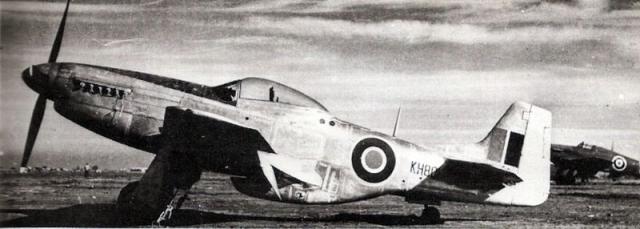
Mustang IV A (KH 801 ?)
(Photo : source inconnue - source unknown)
P-51L
C'était un P-51H mais équipé du moteur Packard (Merlin) V-1650-11 à injection directe. 1 455 furent commandés mais aucun construits compte tenu de la fin de la guerre.
It was a P-51H but fitted with an engine Packard (Merlin) V-1650-11 with direct injetcion. 1,455 units were ordered but none built because of the end of the war.
P-51M
Le P-51M-NT était identique au P-51H. 1 629 furent commandés mais un seul fabriqué (s/n 45-11743). La commande fut annulée avec la fin de la guerre.
the P-51M-NT was a P-51H. 1,629 were ordered but just one built (s/n 45-11743). The order was cancelled with the end of the war.
P-82 Twin Mustang
Le P-82 Twin Mustang était au départ une solution pour pallier au phénomène de fatigue des pilotes sur les longs vols monotones au dessus des océans. Mais au lieu d'être un simple assemblage de deux fuselages de P-51, le P-82 était un avion à part entière, plus long de 1,80 m par rapport au P-51 et avec de nombreuses innovations technologiques. Les cockpits étaient également plus confortables. Les moteurs étaient des Rolls-Royce Merlin V-1650-23 et V-1650-25 (rotation inversée). Les deux cockpits avaient les commandes de gaz mais celui du pilote (à gauche) avaient tous les instruments de contrôle ; le copilote (à droite) n'avait que les commandes d'urgence.Le premier prototype XP-82 (NA-120 - s/n 44-83886) vola pour la première fois le 15 avril 1945.
The P-82 Twin Mustang was at the beginning a solution to compensate the problem of tiredness of the pilots during long monotonous flights over the oceans. But instead of being a simple assembly of two P-51 fuselages, the P-82 was a real plane, longer than a P-51 (1.80 m) and had many technological innovations. The cockpits were also more comfortable. The engines were Rolls-Royce Merlin V-1650-23 and V-1650-25 (reversed rotation). The two cockpits had the throttle control but only the pilot (on the left) had all the instruments of control ; the copilot (on the right) had only the emergency controls. The first prototype XP-82 (NA-120 - s/n 44-83886) flew for the first time on April 15th, 1945.
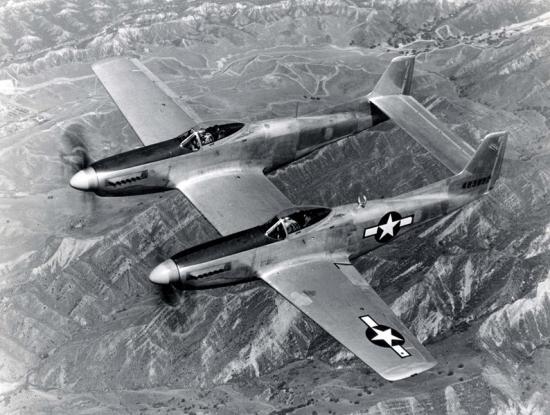
2nd prototype XP-82 (s/n 44-83887)
(source : USAF - Domaine public - Public domain)
Le troisième prototype (NA-123, XP-82A) reçut des moteurs Allison V-1710 mais ne fut jamais achevé. 500 P-82 (P-82B, très similaires aux XP-82A) furent commandés le 8 mars 1944 mais seulement 20 furent fabriqués. Après la guerre, 2 de ces 20 modèles furent convertis en chasseurs de nuit sous le nom de P-82C (radar SCR-720) et P-82D (radar APS-4). Le copilote effectuait la veille radar. Le 12 décembre 1945, l'U.S.A.A.F. commanda 100 chasseurs d'escorte P-82E (NA-144), 100 chasseurs de nuit P-82F (NA-149) avec le radar SCR-720 et 50 chasseurs de nuit P-82G (NA-150).
The third prototype (NA-123, XP-82A) got engines Allison V-1710 but was never completed. 500 P-82 (P-82Bs, very similar to XP-82A) were ordered on March 8th, 1944 but only 20 were manufactured. After the war, 2 of these 20 models were converted into night fighters under the name P-82C (radar SCR-720) and P-82D (radar APS-4). The copilot was in charge of radar control. On December 12th, 1945, the U.S.A.A.F ordered 100 escort fighters P-82E (NA-144), 100 night fighters P-82F (NA-149) with radar SCR-720 and 50 night fighters P-82G (NA-150).
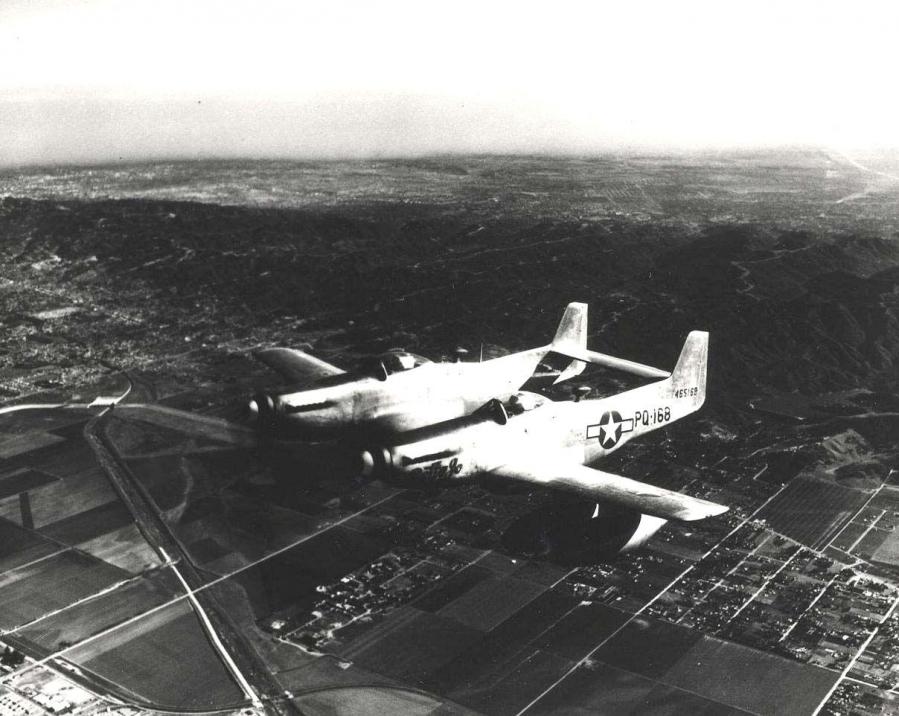
F-82B 'Betty Jo' (s/n 44-65169)
Photo USAF (Domaine public - Public domain)
Ces 250 avions furent fabriqués entre 1946 et 1949 mais neuf P-82F et cinq P-82G furent convertis pour des opérations en climat froid sous le nom de P-82H. En 1948, les dénominations passèrent de P (Pursuit) à F (Fighter) : des F-82 furent engagés en guerre de Corée.
These 250 planes were manufactured between 1946 and 1949 but nine P-82F and five P-82G were converted for operations in cold climate under the name P-82H. In 1948, the denominations switched from P (Pursuit) to F (Fighter) : F-82s were engaged in the Korean war.
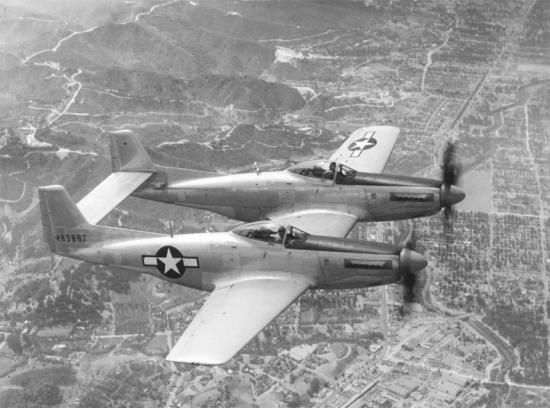
2nd prototype XP-82 (s/n 44-83887)
(source : USAF - Domaine public - Public domain)
Après la guerre - After the war
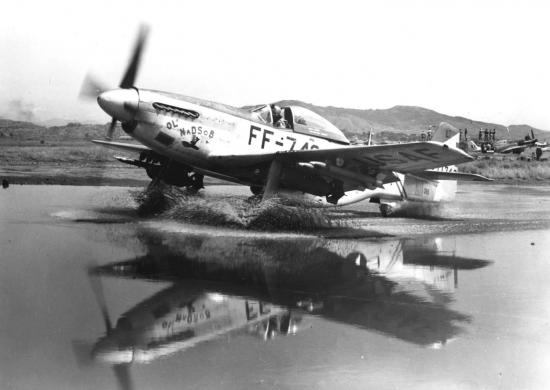
F-51H - Début des années 50 à la guerre de Corée - Early 50's in Korean war.
(source : USAF - Domaine public - Public domain)
Le Mustang servit encore une dizaine d'année dans différentes aviations militaires. Il prit le nom de F-51 à partir de 1948 (F pour Fighter remplaçait le P pour Pursuit). L'Angleterre en céda à l'Union Soviétique. L'U.S.A.A.F. en vendit immédiatement après la guerre aux forces aériennes bolivienne, salvadorienne, haïtienne, italienne, suédoise, suisse, chinoise nationaliste, indonésienne, philippine, canadienne, australienne, néo-zélandaise et française.
The Mustang still served for about ten year in various military air forces. It became F-51 from 1948 (F for Fighter replaced P for Pursuit). England gave some to the Soviet Union. The U.S.A.A.F sold some units immediately after the war to the Bolivian, Salvadoran, Italian, Swedish, Swiss, Chinese nationalist, Indonesian, Filipino, Canadian, Australian, New Zealand and French air forces .


North American P-51D (ex-44-73350), Salvador
Avant et après application d'un camouflage en 1969. Before and after application of camouflage in 1969.
© Vincent Dhorne
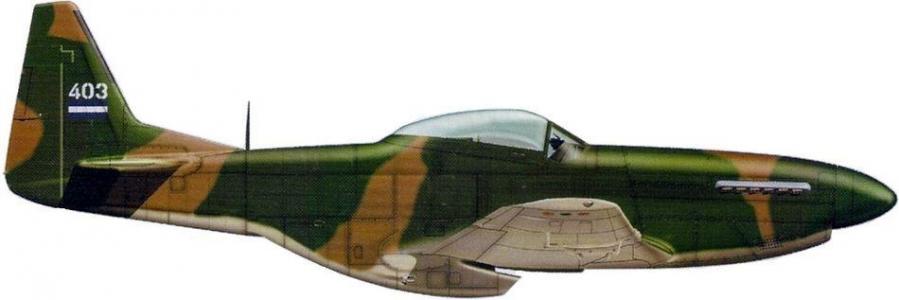
Cavalier "Mustang", Salvador © Vincent Dhorne

Cavalier "Mustang", Salvador © Vincent Dhorne

North American F-51D (ex-44-15T653), Brown Field, Port-au-Prince, Haïti
© Srecko Bradic - www.sreckobradic.com

Mustang P-51D
Marquages chinois - Chinese marks
© Srecko Bradic - www.sreckobradic.com

Mustang P-51D
People's Liberation Army Air Force, Chine/China - 1951
© Jean-Marie Guillou
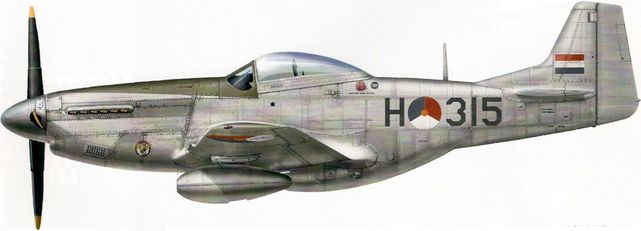
Mustang P-51D-20-NT (s/n 44-13046) - Photo Verkennings Afdeling, 1948-1949 (ML-KNIL)
Indes Néerlandaises- Netherlands Indies.
© Dekker Art Work (Thierry Dekker) : http://dekker-artwork.blogspot.fr
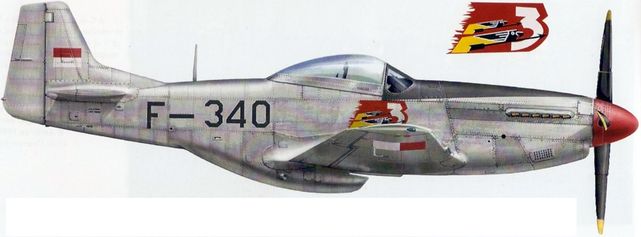
Mustang P-51D-25-NT (s/n 44-84803) - 3 Skuadron, AURI
Force aérienne indonésienne, Andir, été 1950 - Indonesian air force, Andir, summer 1950.
© Dekker Art Work (Thierry Dekker) : http://dekker-artwork.blogspot.fr
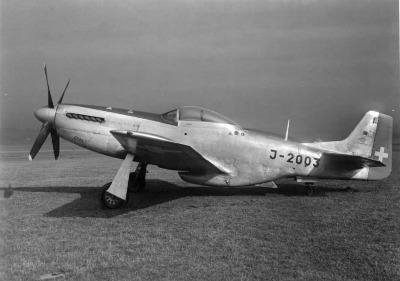
Mustang P-51D-20-NA J-2003 (s/n 44-72350) Swiss Air Force
Photo : source inconnue - source unknown

Mustang P-51D-20-NA J-2003 (s/n 44-72350) Swiss Air Force
© Srecko Bradic - www.sreckobradic.com
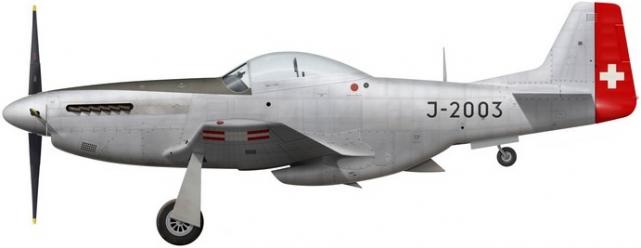
Mustang P-51D-20-NA J-2003 (s/n 44-72350) Swiss Air Force
© Gaëtan Marie - Mustang !

Mustang P-51D-20-NA J-2010 (s/n 44-72212) Swiss Air Force, 1950
© Srecko Bradic - www.sreckobradic.com

Mustang P-51D-25-NA J-2061 (s/n 44-72774) Swiss Air Force, 1952
© Srecko Bradic - www.sreckobradic.com

Mustang P-51D-20-NA J-2063 (s/n 44-64149) Swiss Air Force, 1953
© Srecko Bradic - www.sreckobradic.com
En 1947, différents pays d'Amérique latine reçurent des P-51 qu'ils utilisèrent jusque dans les années 70.
In 1947, various Latin American countries received P-51s that they used until the Seventies.

Mustang F-51D Fuerza Aerea Boliviana (FAB) - Bolivie - Bolivia
© Srecko Bradic - www.sreckobradic.com

North American P-51D Escuadrón Cuervo - Fuerza Aérea Guatemalteca, La Aurora, Guatemala, 1963
© Srecko Bradic - www.sreckobradic.com

Mustang F-51D, Escuadron de Caza, "Ramfis", Fuerza Aéreas Dominicana,
BA Trujillo, Santo Domingo, 1964
© Srecko Bradic - www.sreckobradic.com

Mustang F-51D (FAD 1900), Escuadron de Caza, San Isidoro
République Dominicaine - Dominican Republic, 1970
© Pierre-André Tilley
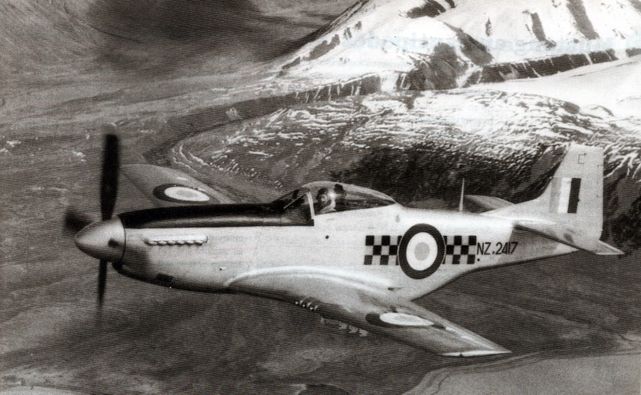
Mustang P-51D-25-NT (NZ2417), N°3 (Canterbury) Squadron - Mount Cook
© RNZAF http://airforce.mil.nz
Début 1945, la RNZAF souhaite remplacer ses Corsair par des P-51. Un premier lot de 30 Mustangs P-51D-25-NT (serials 45-11490 à 11522), fabriqués à Dallas, sont mis en caisse et embarqués à bord des Dominion Park et Winnepogosis Park pour la Nouvelle-Zélande. Les 25 premiers seront pris en charge à Hobsonville (près d'Auckland) le 27 août 1945 et les 5 autres le 6 septembre. Ils porteront les serials NZ2401 à NZ2430. La fin de la guerre change la destination de ces Mustangs qui seront stockés au N°1 Stores Depot à Te Rapa (Hamilton) .
Early 1945, the RNZAF wished to replace its Corsair by P-51. A first batch of 30 Mustangs P-51D-25-NT (serials 45-11490 to 11522), manufactured in Dallas, were loaded into containers and embarked on board Dominion Park and Winnepogosis Park towards New Zealand. The 25 first arrived in Hobsonville (near Auckland) on August 27th, 1945 and the 5 others on September 6th. They carried serials NZ2401 to NZ2430. The end of the war changed the destination of these Mustangs which were stored in N°1 Stores Depot at Te Rapa (Hamilton).

Mustang P-51D-25-NT (NZ2414), N°1 (Auckland) Squadron - Whenuapai, 1954
© Pierre-André Tilley


Mustang P-51D-25-NT (NZ2422), N°2 (Wellington) Squadron - Ohakea, 1954
© Pierre-André Tilley

Mustang P-51D-25-NT (NZ2409), N°3 (Canterbury) Squadron - Wigram, 1954
© Pierre-André Tilley
Ce n'est qu'en 1951, après la création de la Territorial Air Force (TAF), que ces Mustangs sont affectés : 5 Mustangs à chaque Squadron (1 à 4) et 10 autres en réserve. Ces Mustangs seront utilisés par les pilotes réservistes de ces 4 Squadrons et certains seront détruits sur accidents. Les derniers seront radiés en 1955 et le dernier vol effectué le 30 mai 1957.
It is only in 1951, after the creation of Territorial Air Force (TAF), that these Mustangs were affected : 5 Mustangs for each Squadron (1 to 4) and 10 others in reserve. These Mustangs were flown by reservist pilots from these 4 Squadrons and some were destroyed on accidents. The last were erased in 1955 and the last flight carried out on May 30th, 1957.

Mustang P-51D-25-NT (NZ2410), N°4 (Otago) Squadron - Taieri, 1954
© Pierre-André Tilley

Mustang P-51D-25-NT (NZ2429), N°4 (Otago) Squadron - Taieri, 1953
© Pierre-André Tilley

Une compagnie américaine, la Trans-Florida Aviation Inc., eut l'idée d'acquérir des Mustang pour les convertir en avions d'affaires biplaces et proposa les modèles Cavalier Special et Cavalier 2000. Face au succés de ces avions, la société pris le nom de Cavalier Aircraft Corporation en 1962. En 1967, elle créa un avion anti-guérilla pour l'US Air Force : le Cavalier Mustang II. Mais l'avion ne fut finalement pas commandé. La société conçu alors le Mustang III à réaction sur la base d'un Mustang II. Cet avion devint Enforcer après le rachat de la Cavalier Aircraft Corp. par Piper Aircraft mais ne fut produit qu'en faibles quantités.
An American company, the Trans-Florida Aviation Inc., had the idea to acquire Mustangs to convert them into two-seater business aircrafts and proposed the models Cavalier Special and Cavalier 2000. The success of these planes led the company to take the name of Cavalier Aircraft Corporation in 1962. In 1967, it created a anti-insurgency plane for the US Air Force : the Cavalier Mustang II. But the plane was finally not ordered. The company then created the Mustang III jet plane on the basis of the Mustang II. This plane became Enforcer after the purchase of the Cavalier Aircraft Corp. by Piper Aircraft but was produced only in small quantities.
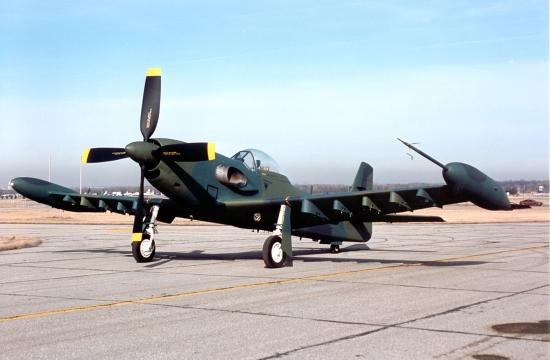
Piper PA48 Enforcer
(source : USAF - Domaine public - Public domain)
Production étrangère - Foreign production
Seule la C.A.C. (Commonwealth Aircraft Corporation) en Australie fabriqua des P-51 sous licence pour la R.A.A.F. que l'Angleterre ne pouvait approvisonner en chasseurs modernes. En 1943, la N.A.A. envoya en Australie des composants pour fabriquer 100 P-51. 80 furent assemblés sous le nom CA-17 Mustang XX (s/n A68-1 à A68-80).
Only the C.A.C. (Commonwealth Aircraft Corporation) in Australia manufactured P-51s under license for the R.A.A.F. which could not be supplied in modern fighters by England. In 1943, the N.A.A. sent in Australia components to manufacture 100 P-51. 80 were assembled under the name CA-17 Mustang XX (s/n A68-1 to A68-80).
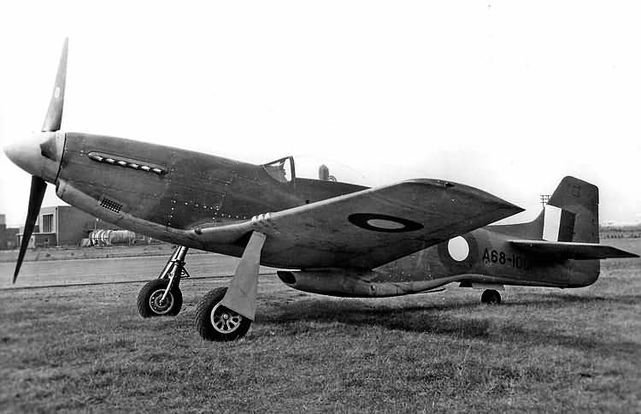
North American NA-109 P-51D Mustang IV (A68-1001 c/n 109-26926) R.A.A.F.
Laverton, Victoria, Australia, 1947-49
P-51D fourni par la N.A.A. pour servir de patron à l'assemblage des Mk 20
P-51D supplied by the N.A.A. to be used as a pattern for Mk 20 assembly
Picture with courtesy of Australian War Memorial (http://www.awm.gov.au)
Le premier vola en avril 1945. A la fin de la guerre, 120 autres Mustang (CA-18) avaient été fabriqués en Australie : 26 Mustang XXI (moteurs Packard V-1650-7), 28 Mustang XXII identiques au XXI mais avec une caméra K-24 et 66 Mustang XXIII (moteurs Merlin 66 et 70 fournis par Rolls Royce).
The first one flew in April 1945. At the end of the war, 120 other Mustang (CA-18) had been manufactured in Australia : 26 Mustang XXI (engines Packard V-1650-7), 28 Mustang XXII similar to the XXI but with a K-24 camera and 66 Mustang XXIII (fitted with engines Merlin 66 and 70 supplied by Rolls Royce).
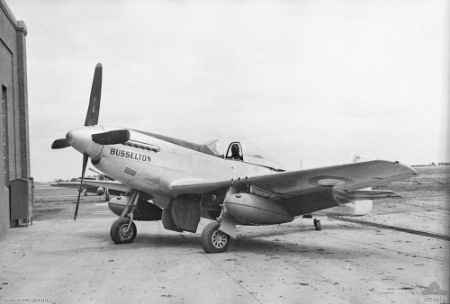
CA-17 Mustang Mk 20 (s/n A68-33) - RAAF Base Laverton
Picture with courtesy of Australian War Memorial (http://www.awm.gov.au)

